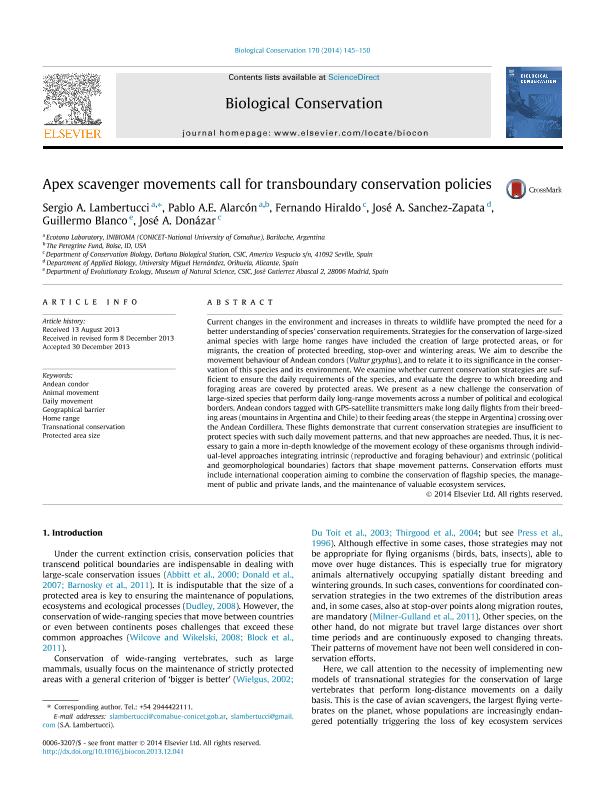Mostrar el registro sencillo del ítem
dc.contributor.author
Lambertucci, Sergio Agustin

dc.contributor.author
Alarcón, Pablo Angel Eduardo

dc.contributor.author
Hiraldo, Fernando

dc.contributor.author
Sánchez Zapata, José A.
dc.contributor.author
Blanco, Guillermo

dc.contributor.author
Donázar, José A.
dc.date.available
2017-09-18T22:04:57Z
dc.date.issued
2014-01-25
dc.identifier.citation
Lambertucci, Sergio Agustin; Alarcón, Pablo Angel Eduardo; Hiraldo, Fernando; Sánchez Zapata, José A.; Blanco, Guillermo; et al.; Apex scavenger movements call for transboundary conservation policies; Elsevier; Biological Conservation; 170; 25-1-2014; 145-150
dc.identifier.issn
0006-3207
dc.identifier.uri
http://hdl.handle.net/11336/24542
dc.description.abstract
Current changes in the environment and increases in threats to wildlife have prompted the need for a better understanding of species´ conservation requirements. Strategies for the conservation of large-sized animal species with large home ranges have included the creation of large protected areas, or for migrants, the creation of protected breeding, stop-over and wintering areas. We aim to describe the movement behaviour of Andean condors (Vultur gryphus), and to relate this movement to its significance in the conservation of this species and its environment. We examine whether current conservation strategies are sufficient to ensure the daily requirements of the species, and evaluate the degree to which breeding and foraging areas are covered by protected areas. We present as a new challenge the conservation of large-sized species that perform daily long-range movements across a number of political and ecological borders. Andean condors tagged with GPS-satellite transmitters make long daily flights from their breeding areas (mountains in Argentina and Chile) to their feeding areas (the steppe in Argentina) crossing over the Andean Cordillera. These flights demonstrate that current conservation strategies are insufficient to protect species with such daily movement patterns, and that new approaches are needed. Thus, it is necessary to gain a more in-depth knowledge of the movement ecology of these organisms through individual-level approaches integrating intrinsic (reproductive and foraging behaviour) and extrinsic (political and geomorphological boundaries) factors that shape movement patterns. Conservation efforts must include international cooperation aiming to combine the conservation of flagship species, the management of public and private lands, and the maintenance of valuable ecosystem services.
dc.format
application/pdf
dc.language.iso
eng
dc.publisher
Elsevier

dc.rights
info:eu-repo/semantics/openAccess
dc.rights.uri
https://creativecommons.org/licenses/by-nc-sa/2.5/ar/
dc.subject
Transnational Conservation
dc.subject
Animal Movement
dc.subject
Home Range
dc.subject
Protected Area Size
dc.subject
Andean Condor
dc.subject
Daily Movement
dc.subject
Geographical Barrier
dc.subject.classification
Bioquímica y Biología Molecular

dc.subject.classification
Ciencias Biológicas

dc.subject.classification
CIENCIAS NATURALES Y EXACTAS

dc.title
Apex scavenger movements call for transboundary conservation policies
dc.type
info:eu-repo/semantics/article
dc.type
info:ar-repo/semantics/artículo
dc.type
info:eu-repo/semantics/publishedVersion
dc.date.updated
2017-08-09T14:05:31Z
dc.journal.volume
170
dc.journal.pagination
145-150
dc.journal.pais
Países Bajos

dc.journal.ciudad
Ámsterdam
dc.description.fil
Fil: Lambertucci, Sergio Agustin. Universidad Nacional del Comahue. Centro Regional Universitario Bariloche. Laboratorio de Ecotono; Argentina. Consejo Nacional de Investigaciones Científicas y Técnicas. Centro Científico Tecnológico Conicet - Patagonia Norte. Instituto de Investigaciones en Biodiversidad y Medioambiente. Universidad Nacional del Comahue. Centro Regional Universidad Bariloche. Instituto de Investigaciones en Biodiversidad y Medioambiente; Argentina
dc.description.fil
Fil: Alarcón, Pablo Angel Eduardo. The Peregrine Fund; Estados Unidos. Consejo Nacional de Investigaciones Científicas y Técnicas. Centro Científico Tecnológico Conicet - Patagonia Norte. Instituto de Investigaciones en Biodiversidad y Medioambiente. Universidad Nacional del Comahue. Centro Regional Universidad Bariloche. Instituto de Investigaciones en Biodiversidad y Medioambiente; Argentina. Universidad Nacional del Comahue. Centro Regional Universitario Bariloche. Laboratorio de Ecotono; Argentina
dc.description.fil
Fil: Hiraldo, Fernando. Consejo Superior de Investigaciones Cientificas; España
dc.description.fil
Fil: Sánchez Zapata, José A.. Universidad de Miguel Hernández; España
dc.description.fil
Fil: Blanco, Guillermo. Consejo Superior de Investigaciones Cientificas; España
dc.description.fil
Fil: Donázar, José A.. Consejo Superior de Investigaciones Cientificas; España
dc.journal.title
Biological Conservation

dc.relation.alternativeid
info:eu-repo/semantics/altIdentifier/doi/http://dx.doi.org/10.1016/j.biocon.2013.12.041
dc.relation.alternativeid
info:eu-repo/semantics/altIdentifier/url/http://www.sciencedirect.com/science/article/pii/S0006320714000020
Archivos asociados
